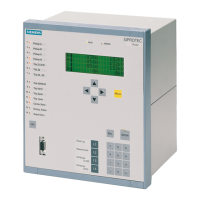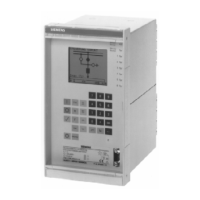2.9 Thermal Overload Protection
229
7UT613/63x Manual
C53000-G1176-C160-2
that corresponds with the setting in accordance with the functional scope (section
2.1.3.1) under address 191 RTD CONNECTION.
The characteristic values of the temperature detectors are set separately, see section
RTD-boxes 2.10).
Hot-Spot Stages There are two annunciation stages for hot-spot temperature. To set a specific hot-spot
temperature value (expressed in °C), which is meant to generate the warning signal
(stage 1), use address 4222 HOT SPOT ST. 1. Use address 4224 HOT SPOT ST.
2 to indicate the corresponding alarm temperature (stage 2). It can also be used for
the tripping of circuit breakers if the outgoing message (No 1542) is allocated to a trip
relay.
If address 276TEMP. UNIT is set to degree Fahrenheit during configuration of the
Power System Data 1, thresholds for warning and alarm temperatures have to be
expressed in Fahrenheit at addresses 4223 and 4225.
If the temperature unit is changed in address 276, after having set the thresholds for
temperature, these thresholds changed for the temperature unit, must be reset in the
respective addresses.
Ageing Rate For ageing rate L thresholds can also be set, i.e. for the warning signal (Stage 1) in
address 4226AG. RATE ST. 1 and for alarm signal (Stage 2) in address 4227AG.
RATE ST. 2. This information is referred to the relative ageing, i.e. L=1 is reached at
98°C or 208°F at the hot spot. L > 1 refers to an accelerated ageing, L < 1 to delayed
ageing.
Cooling Method
and Insulation Data
Set in address 4231 METH.COOLING which cooling method is used: ON = Oil Natural
for natural cooling, OF = Oil Forced for oil forced cooling or OD= Oil Directed for oil di-
rected cooling. The definitions under margin heading „Cooling Methods“ in the func-
tion description of the hot-spot calculation.
For hot-spot calculation, the device requires winding exponent Y and the hot-spot to
top-oil gradient H
gr
, that can be set under 4232 Y-WIND.EXPONENT and 4233 HOT-
SPOT GR. If the corresponding information is not available, it can be taken from the
IEC 60354. An extract from the corresponding table of the standard with the technical
data relevant for this project can be found hereinafter.
Table 2-9 Thermal characteristics of power transformers
Additional Thermal
Overload Protec-
tion Function
In the aforementioned description, the first thermal overload protection is described re-
spectively. The differences in the parameter addresses and message numbers of the
first and second thermal overload protection are illustrated in the following table. The
positions marked by x are identical.
Cooling method:
Distribution
transformers
Medium and large power
transformers
ONAN ON.. OF.. OD..
Winding exponent Y 1.6 1.8 1.8 2.0
Insulation temperature gradient H
gr
23 26 22 29
Parameter addresses Message no.
1. thermal overload protection function 42xx 044.xxxx(.01)
2. thermal overload protection function 44xx 204.xxxx(.01)
